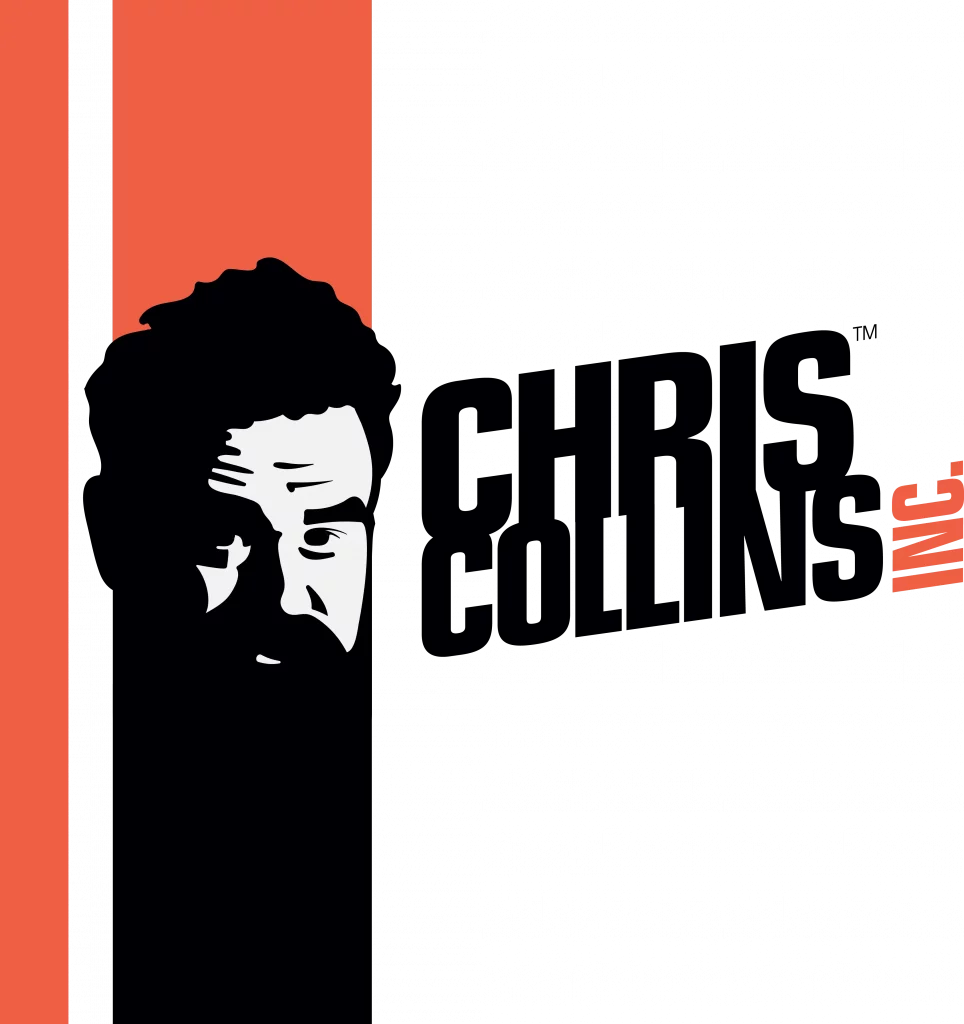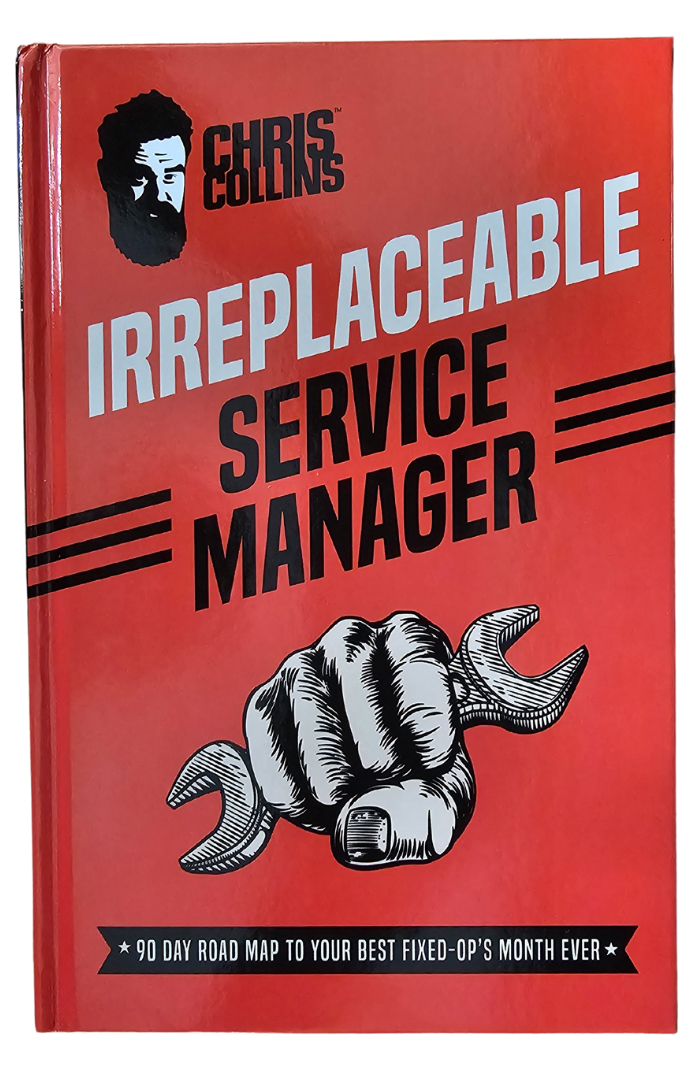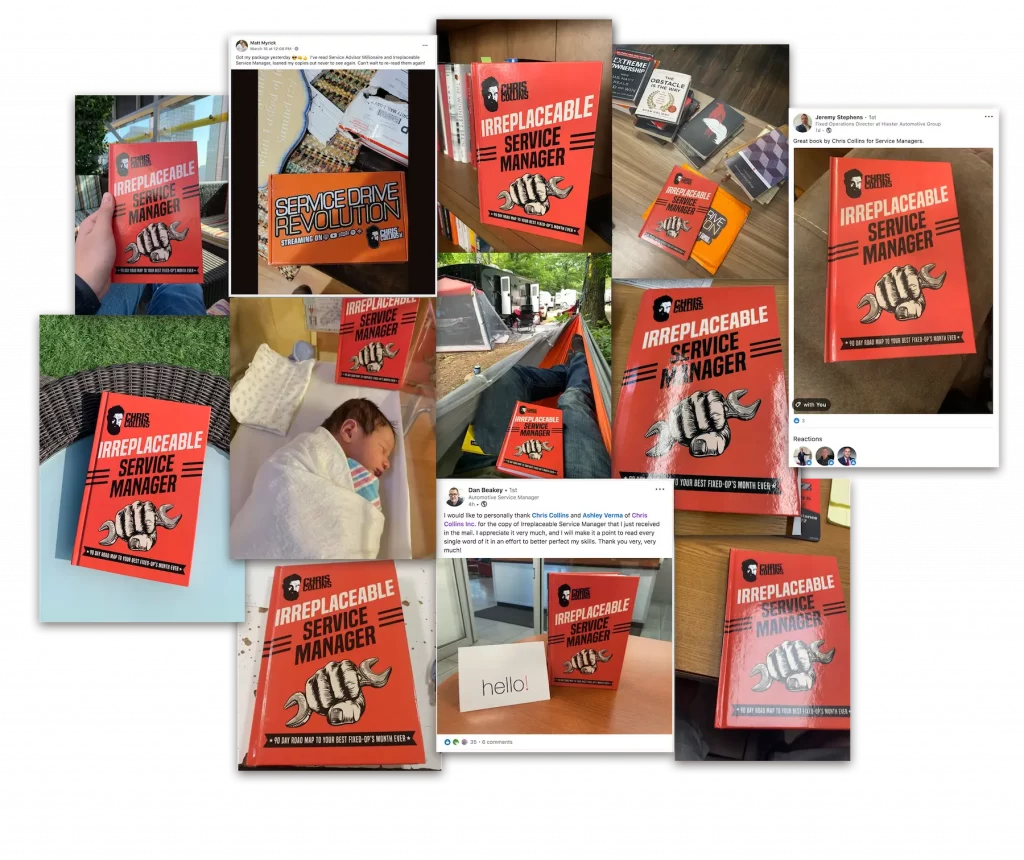Forward by Chris Collins:
You’re about to learn a simple system that will allow you to escape the rat race, have more fun, and make more money in your service department in less time, and with fewer headaches.
It’s a system that Managers just like you are using to increase profits by four-hundred percent and CSI scores by four or five points, all within ninety days.
Instead of feeling like you’re strapped to your desk all day responding to emails and dealing with that never-ending stream of employees coming in asking if you’ve “got a minute,” you’re going to be able to gain total control of your department with minimum stress and maximum efficiency.
Efficiency is one of the biggest keys to regaining control of your most important asset-- Your time.
With more time at your disposal, you’ll have the freedom to do the most important stuff, like help your kids with homework, enjoy dinner with your family, or just do things you love.
I know there’s a lot of Service Managers who are putting in ten, twelve hour days. It’s definitely a noble thing, and I commend you for being such a hard worker.
I know that can be tough.
When I was the General Manager of the #1 BMW dealership in the world, I was married to my job. We had over 340 employees, and my day basically consisted of a revolving door of people coming into my office asking me to make decisions.
I learned early on that the only way I was going to succeed is if I learned how to leverage my time better and hold myself and others accountable.
I needed a system.
Today, I’m always writing new books and recording new episodes of my podcast, and creating new training content for my OnDemand training platform, all while I’m having a lot of fun…
And I’m constantly getting asked by the guys in my Coaching Group how I do it when they’re all struggling just getting menus done. The truth is, it took me years of trial and error to learn that it’s possible to get more done while putting in less hours.
I learned the hard way so you don’t have to, so I’m going to teach you the very same system that took me years to learn. I hope it helps you take back more of your time in the long run.
Wake up earlier.
You gotta get up earlier. That’s the only way to do this and to get where you want to go.
When you start getting up earlier, guess what’s going to happen? You’re going to start going to bed earlier, and the whole cycle will take care of itself! You have nothing to worry about. The laws of nature will take over, and you’ll be fine.
Have a morning ritual.
Most successful people have some sort of morning ritual: Bill Gates says he reads for an hour every morning, some guys meditate, work out, or do some sort of visualization type strategy to visualize their results. You know, that sort of thing.
The point of having a morning ritual is this that, from the beginning of time, we’ve been programmed to hunt. That’s what we do. Even though a lot of guys today sit around and they say, “Well I’m just looking to be happy and content,” the truth is that happiness is found in motion and action. The more action you take, the happier you’re going to be.
So you need to wake up and put yourself into a mindset of action. You gotta wake up every day with the intent to hunt and go kill stuff. It’s not an easy thing, it takes a lot of effort, but that’s the key to success: Get in touch with your inner self and wake up to hunt.
Write Down Your Goals.
I want you to write down your goals, and conquer them.
I keep a notepad and I write the date, where I’m at, because I’m usually traveling all over the country all the time, and then I write out my goals. I close my eyes and I actually visualize my goals, monetary goals and personal goals, and say them over and over again.
Now, I actually do my goals twice a day– once in the morning and once in the evening– because I read a study that said if you write your goals down you’re 58% more likely to accomplish them. So if I do them twice a day, I’m that much more likely to accomplish them.
That’s what I tell myself, anyway, and it’s worked out for me so far.
So after doing this, I write a list of the things I want to accomplish that day. I like to make that list after I visualize my goals, because then all of the things I’m going to accomplish that day are in direct relation to my goals.
Work out.
This one is kind of a continuation of the morning routine for me, because I always work out in the morning. I find that a workout in the morning usually gives me a lot of energy, and gives me a lot of momentum early on. That momentum carries me throughout the rest of my day.
Maybe you work out in the morning, maybe in the afternoon or evening. Maybe it’s a struggle for you, maybe it’s not. The most important part is that you just get in some kind of workout.
Now I can hear you say, “Well, Chris, I don’t have time to do that. I’m rushing out the door.”
To that I say: Refer to Step 1.
Intervals.
Now, when you get to work, after you’ve done your morning ritual and your goals, the key to success is to focus on something that is programmed inside of us: the rhythm of time. The world functions in 60-minute intervals, so you want to break your day up into 60-minute intervals.
Then for the first 45 minutes of your day, I want you to take your list of accomplishments for the day and I want you to schedule those into 45-minute increments. Let’s say, for example, you wrote, “I’m going to work on menus.” Write that goal into a 45-minute interval.
Set a timer for 45 minutes. During that 45 minutes there’s no checking email, there’s no answering the phone, you’re going to turn all that off. With your door closed and no distractions, you’re going to focus exclusively on those menus for 45 minutes.
If the building’s on fire you’ll hear the sirens, but beyond that you don’t need to be interrupted. Then after 45 minutes, the timer is going to ping, and you’re going to take a fifteen minute break.
If you do this two times throughout the day, then you’ve leveraged an hour and a half every day to be super productive. You’ll be so much more successful and get so much more done.
You might want to talk to your dealer about this, because if they’re like me, they like to have the phone answered when somebody calls. So just as a preventative measure, it’s nice to give them a little heads up to avoid getting chewed out.
The rest of the time you can walk through the dealership, you can do all kinds of other things.
I can already hear you saying that’s impossible because you’re constantly having to put out fires, but don’t worry… I have a solution for that too.
Got-a-minutes.
Now, if you can’t accomplish things in sixty minute time slots because people are constantly coming into your office and interrupting you, you need to retrain them and retrain yourself.
A lot of times, when my team and I go in to talk to the Service Managers, we get interrupted constantly. A Service Advisor comes in and says, “You got a minute? Can I ask you a question?”
Remember that, in our industry, there are no new problems. There are some slight nuances, obviously, but in terms of customer service everything is basically the same as it was thirty years ago… And, ultimately, the Service Advisor’s job is to take care of customers.
Back in the day, customers would roll into the shop and the technician would help them directly. Many independents still work this way. Nowadays, we have all these layers: Service Advisors, BDC, cashier, greeters… and all of those layers do one of two things:
They help the process, or they hurt the process.
If they’re not helping the process, then they don’t need to be there. There’s no new customer problems, and unless the building is on fire there’s no reason they need to come into your office. Service Advisors need to own their customers, and all that takes is a little bit more effort.
So I want you to start doing this for me:
Starting tomorrow, when a Service Advisor comes into your office to ask a question, whatever their question is, I want you to say, “What would you do?”
I don’t want you to answer their question, I want you to say, “What would you do?”
Then, if their answer is semi-competent, I want you to say, “So what do you need me for? You got this. You’re a pro.”
That’s what I want you to do, and I guarantee you’ll get rid of the dreaded “got-a-minutes.”
Even if you didn’t do any of the other stuff on this list, if you just get rid of the got-a-minutes you would be tremendously more successful, because that’s just how much time is wasted on these.
Decision Fatigue.
Einstein didn’t know his phone number, because he said, “Why would I learn something that I can easily look up?” Decision fatigue is a real thing, and if you’re dealing with got-a-minutes all day then you’re going to get decision fatigue.
What you want to do is keep all the got-a-minutes and tiny decisions that other people can easily make on their own away from you, and you want to make the high-level decisions, because those are the ones that are going to make you the most money.
The famous Steve Jobs wore a uniform because he didn’t want to worry about it. A lot of very successful people wear the same clothes every day. If they like a shirt, they buy twelve of them.
I do this with my clothes. I travel a lot, so I buy the same pants from Ralph Lauren, because their slacks have cinches instead of belt loops. So, when I go through the airport, I don’t have to take off my belt and I can get through TSA faster. So, I order ten pairs of these pants at a time and I wear them all year. When I pack it’s easy, I know I’m always wearing these black slacks.
It isn’t limited to clothes, though. For example, it can be checking emails constantly. Just check emails two or three times a day. Answer them and then be done. If you’re constantly checking them, you’re going to get decision fatigue.
Know how much time you have.
I once had a mentor tell me, “Take out a tape measure to 77,” because the average male in America lives to be seventy-seven. I did that, and then he said, “Now go to your age.”
So I went to 42, because I was 42 years old, and when I looked at that, I realized that more than half of my life was over! And that’s if I’m lucky enough to live to seventy-seven!
That’s a very serious thing to understand– that your time is your most valuable asset.
Your time is all you have, and it’s a literal death sentence to allow people to waste your time and control your day. You don’t want to be seventy-seven and looking back on your life and realize that you don’t know if you won or lost.
If you do this with a tape measure, it’ll have a profound effect on you.
Roll out the tape measure and look at that last part of life that you have left, and you’ll realize that you don’t want it to be controlled by other people. You want to control it.
So don’t let other people waste your time!
Accountability.
It’s your job as a leader to give your team the tools to do their job, but you shouldn’t be doing their job for them. If you’re doing their job for them, you’re letting them control your time.
If you constantly have customer phone calls because your Advisors don’t know how to take care of customers, you’re allowing that to happen. So you have to start holding people accountable.
You control your time, they control theirs.
Every time you get a customer complaint, you should sit down with the Advisor and the tech and tell them, “There’s no new customer problems, the only difference is you didn’t take this and own it. You didn’t care to double check your work. You didn’t care to call the customer one more time. You didn’t have empathy. You didn’t apologize enough.”
Whatever it is, the Advisor has the capacity to fix it, if they decide to go that extra step to do it. They control their own time, and not yours. If everybody is held accountable for their time, then everyone uses their time to be the most effective at their job, and everyone has the most fun.
During my last year as the General Manager at that BMW store I felt bad taking a paycheck. My Managers were so effective, and every employee at every level owned their responsibility and were all so effective, that I could go weeks without getting a customer complaint.
It made me so much more effective on the front end, and morale in every single department of the store was always sky high. That could be you, and you could have a lot of fun doing it.
I guarantee that once you plug in this formula, both your productivity and your profits are going to shoot through the roof. Now, once you start plugging in this simple formula you’ll start seeing results in the day-to-day operations of your department, but you’ll notice that I actually haven’t covered the “money” part just yet, and there’s a very good reason for that.
Know your financials.
When you’ve printed that out, I want you to take 20 minutes to watch the video below.
You should follow along with me the first time you watch it, but I urge you to get a hold of a recent financial statement for your department and plug your own numbers into the worksheet to get the most accurate understanding of your financials as possible.
Your financials are the clearest indicator of the health of your department, and your job security. If there is one guarantee I can give you, it’s that once you finish this exercise and understand how to read your financial statement, you’ll never be in danger of losing money in your department ever again.
Seriously, never again.
See, we all want more traffic and to grow our RO counts, but if you don’t have this formula down then you could actually be losing money by chasing more traffic. So check out the video below, and I’m going to show you how to stop chasing ROs and start actually making money.
It’s crazy that in our industry financial statements are mostly a mystery. That drives me crazy. Trying to run a business without knowing your financials is like driving with a blindfold on.
So if you walk through this video again but use your own numbers, it’s going to help you understand the financial statement and profitability of your department a little bit better.
Now, like I mentioned at the end of this video, I have a one-of-a-kind system that can boost your profits by 400% or more and increase your CSI score by 4 or 5 points in just 90 days.
This is the exact same system that Donna and Tom in Fort Wayne, Indiana used to increase their effective labor rate by $30.13 and their total monthly sales by $205,000.
Turnersville Kia in New Jersey went from losing money to increasing their effective labor rate by $10.02, and their RO count went up 12%, and their customer and pay labor sales went up 69%.
That’s huge.
All this while our industry continues to suffer from dropping RO counts, low fixed absorption and inconsistent customer satisfaction numbers.
This system works every single time it’s used in every dealership, without exception.
Would you like to know more? Of course you do. To learn more about my OnDemand Training system, and receive 60% off your first month, just click here:

This site is not a part of the Facebook website or Facebook Inc.
Additionally, This site is NOT endorsed by Facebook in any way.
FACEBOOK is a trademark of FACEBOOK, Inc.
ⓒ Chris Collins Inc. 2021. All rights reserved.


